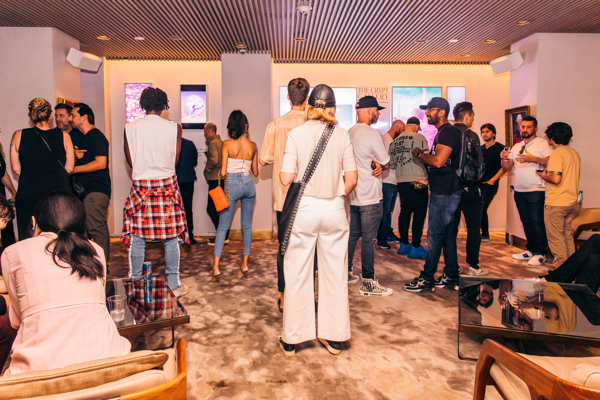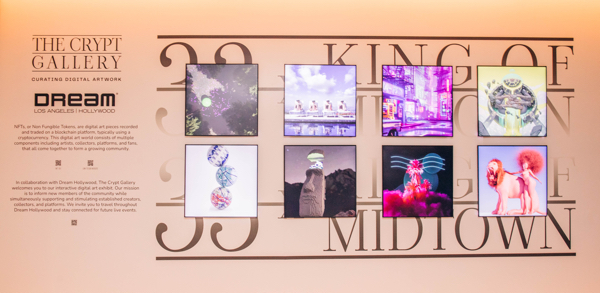At the Dream Hotel in Hollywood, California, the energy of the lobby is electric, -literally-, thanks to an eye-popping gallery of NFT artworks that adorn the walls. As one of the first places in the world to display an NFT art gallery, done in partnership with The Crypt Gallery of New York, The Dream is taking the model of a static hotel art program and turning it on its head.
Contributed by Juliana Shallcross
More than half of the hotel lobby is occupied by various-sized LED frames, each offering a cornucopia of continuously churning digital art. Every artwork has a QR code, which takes viewers to an NFT marketplace. There they can buy the artwork, store it in their digital wallet, and display it on their own devices. For those not in the know about non-fungible tokens, The Dream’s gallery also educates visitors on how NFTs work.

Dream Hollywood General Manager Vaughn Davis believes NFTs are just the tip of the iceberg when it comes to attracting a new generation of consumers, as well as a new way of doing business.
“It’s a completely new transitionary environment,” Davis said of using NFTs to shift the hospitality world from Web 2 to Web 3. “NFT is not just a buzzword. The whole landscape has changed.”
Yet unlike social media where hotels can easily cultivate a following through pretty visuals, the NFT community isn’t easily impressed. Hotels can’t just drop an NFT and expect to make waves. Nor should they release an NFT that is just a piece of art. It needs to have utility and experiences behind it.
“The NFT community is so tight-knit right now that you’re called out if you enter the space wrong,” said Tommy Farr, chief executive officer of Metaverse Hospitality, a digital consultancy firm. Rather, Farr suggested hotels dive deep into understanding the NFT community through discussions on Twitter Spaces and research on Web 3 utilities and cryptocurrencies, before looking at business opportunities.
“I think research and education is still huge right now, so you don’t have to release an NFT project next week,” Farr added. “There’s plenty of time, but you have to do it right.”
When a hotel does decide to drop an NFT, Davis suggested building something that lives in perpetuity, not a one-time NFT such as giving buyers of an NFT artwork a room package at the hotel. “It shouldn’t be a one-time thing,” Davis said. “That defeats the purpose of maintaining something on the blockchain versus actually using the underlying technology to create something that’s unique.”

Beyond selling NFTs in the lobby, The Dream created its Social Club where gaining membership requires the purchase of a limited-edition NFT designed by Perry Cooper. That NFT grants members real-world perks at the hotel such as use of the house car, access to the Gunnar Peterson gym, and room discounts, along with metaverse perks. This NFT has utility in the form of hotel services, but it can also be sold again, much like other NFTs.
“The members love the hotel as it is and now they have a cool piece of art that was created by Perry Cooper and which has trending value,” Davis explained. “So, if they ever decide to sell this art, they make a profit on their membership.”
But NFTs should go beyond art, said Simone Puorto, chief executive officer of Travel Singularity, a technology-focused consulting company. In fact, any piece of a hotel experience can be turned into an NFT – a stay package, a piece of furniture in the room or lobby, or a group dinner at the hotel restaurant. These transactions then remain on the blockchain where it’s decentralized, immutable, and impossible to fake.
“It’s not only about art or a JPEG; it’s more about creating a smart contract every time we do something,” Puorto said. “NFTs are just the shiny part, you know, it’s what we see, and because there’s a lot of money involved. But it’s just a part and it’s not even the most interesting part.”
CitizenM hotels announced a virtual hotel in The Sandbox, a gaming platform in the Metaverse, that would be built through the sale of 2,000 NFTs, which would also give its owners real-world rewards like room discounts and free drinks. Owners of the NFTs would even get to vote on the next location for a real CitizenM hotel.

Casa de Campo, a luxury resort in the Dominican Republic, recently partnered with a new booking platform, Pinktada, to use room night tokens (RNTs) for stays where guests would receive NFTs after the stay is completed. These tokens act like tickets for specific rooms at hotels. They can be used by guests or swapped or even re-sold within the Pinktada platform. The tokens aren’t cryptocurrency per se, but they are acting like one. The NFTs given out are digital highlights and memories of the guest’s stay.
Jason Kycek, Casa de Campo’s senior vice president of sales and marketing, views Pinktada as the Web3 equivalent of the dot-com era online travel agencies, but one that can help hotels enter this complex digital space.
“These guys are first-to-market with this new technology that’s going to build your platform on blockchain technology. That’s the rails,” Kycek said of the Web 3 applications of Pinktada. “And they are not only utilizing that technology, but then incorporating the NFT piece to it.”
Farr believes NFTs could also be applied to a hotel’s loyalty program or function as room keys, ones with valuable art attached. Still, there’s much to figure out with the application of NFTs and blockchain technology in the hospitality space, as the downturn in the crypto world recently pointed out. But the changes will keep happening faster than anything else that’s come before. “We are still so early,” Farr said. “There’s gonna be pivots monthly, weekly, yearly.”
